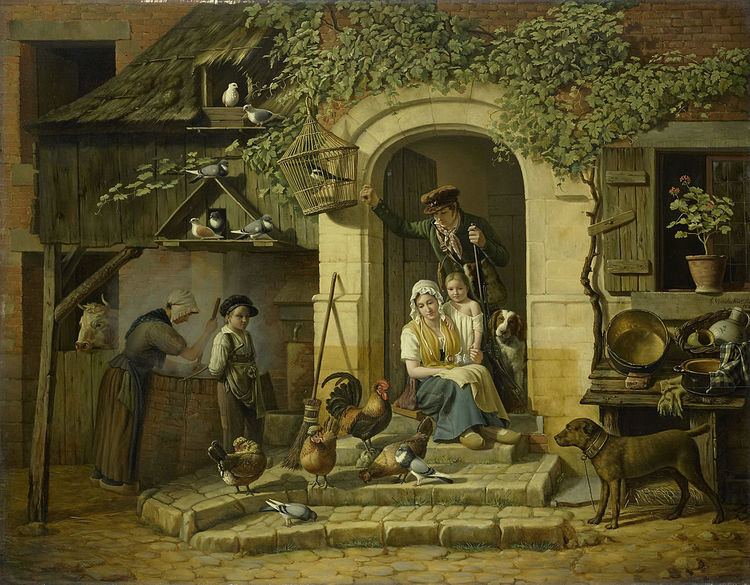Year 1826 Created 1826 | Medium Oil on canvas Artist Henri Voordecker | |
 | ||
Dimensions 203 cm × 162 cm (80 in × 64 in) Owner Rijksmuseum, object nr: SK-A-1157 | ||
Hunter's home or Jagerswoning is an oil painting by Henry Voordecker (15 August 1779, Brussels- 3 December 1861, Brussels), a Belgian artist who painted genre scenes.
Contents
Painting
The painting depicts a hunter at home, surrounded by animals and members of his family; a typical genre painting. As Voordecker's art was in sympathy with the spirit of the age, his success with an audience of wealthy citizens was assured. King William I bought a panel by him in 1820. Hunter's home is owned by the Rijksmuseum in Amsterdam. It depicts a family in front of the door of their home: a mother with a child sitting in the doorway and behind her a young man in hunting clothes. On the steps in front of the house chickens and doves are feeding; to the left of the door yet more doves around a dovecote. On the left a young woman stands at a well and on the right a dog on a chain.
Painter
The son of Pierre Decker and Agnes Rega, Henry Voordecker married Marie Jeanne Guldentops. They had a son, François, and a daughter, Louise; both became artists. Louise was art teacher at the court of King Leopold I and painted mostly fruit and flowers. François Decker was a genre painter and portraitist.
Career
Voordecker studied with Jean-Baptiste Le Roy, who was a Brussels counterpart of the Antwerp animal painter Balthasar-Paul Ommeganck, and Jacques-Louis David, the famous French neoclassical painter who lived in exile in Brussel after 1816s. According to Philippe Bordes, Voordecker may have collaborated with David to paint the figure of Agamemnon in the 1819 version of the painting The Rage of Achille, now in the Kimbell Art Museum, Fort Worth, Texas). He specialized in genre scenes from the beginning of his career, landscapes and animal scenes; in the latter genre predominately pigeons and poultry. Henry Voordecker painted in the romantic style, at once charming and commercial. It is a typical Biedermeier style and its themes characterized by the reinforced feelings of security, gemütlichkeit, traditional simplicity, portraying a sentimental view of the world.
